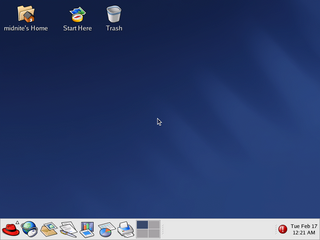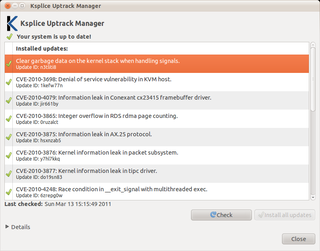
Red Hat Linux was a widely used commercial open-source Linux distribution created by Red Hat until its discontinuation in 2004.

x86-64 is a 64-bit extension of the x86 instruction set architecture first announced in 1999. It introduces two new operating modes: 64-bit mode and compatibility mode, along with a new four-level paging mechanism.
In computing, Physical Address Extension (PAE), sometimes referred to as Page Address Extension, is a memory management feature for the x86 architecture. PAE was first introduced by Intel in the Pentium Pro, and later by AMD in the Athlon processor. It defines a page table hierarchy of three levels (instead of two), with table entries of 64 bits each instead of 32, allowing these CPUs to directly access a physical address space larger than 4 gigabytes (232 bytes).
Buffer overflow protection is any of various techniques used during software development to enhance the security of executable programs by detecting buffer overflows on stack-allocated variables, and preventing them from causing program misbehavior or from becoming serious security vulnerabilities. A stack buffer overflow occurs when a program writes to a memory address on the program's call stack outside of the intended data structure, which is usually a fixed-length buffer. Stack buffer overflow bugs are caused when a program writes more data to a buffer located on the stack than what is actually allocated for that buffer. This almost always results in corruption of adjacent data on the stack, which could lead to program crashes, incorrect operation, or security issues.

MontaVista Software is a company that develops embedded Linux system software, development tools, and related software. Its products are made for other corporations developing embedded systems such as automotive electronics, communications equipment, mobile phones, and other electronic devices and infrastructure.

Ingo Molnár, employed by Red Hat as of May 2013, is a Hungarian Linux hacker. He is known for his contributions to the operating system in terms of security and performance.
Address space layout randomization (ASLR) is a computer security technique involved in preventing exploitation of memory corruption vulnerabilities. In order to prevent an attacker from reliably redirecting code execution to, for example, a particular exploited function in memory, ASLR randomly arranges the address space positions of key data areas of a process, including the base of the executable and the positions of the stack, heap and libraries.
W^X is a security feature in operating systems and virtual machines. It is a memory protection policy whereby every page in a process's or kernel's address space may be either writable or executable, but not both. Without such protection, a program can write CPU instructions in an area of memory intended for data and then run those instructions. This can be dangerous if the writer of the memory is malicious. W^X is the Unix-like terminology for a strict use of the general concept of executable space protection, controlled via the mprotect system call.
seccomp is a computer security facility in the Linux kernel. seccomp allows a process to make a one-way transition into a "secure" state where it cannot make any system calls except exit , sigreturn , read and write to already-open file descriptors. Should it attempt any other system calls, the kernel will either just log the event or terminate the process with SIGKILL or SIGSYS. In this sense, it does not virtualize the system's resources but isolates the process from them entirely.
The OpenBSD operating system focuses on security and the development of security features. According to author Michael W. Lucas, OpenBSD "is widely regarded as the most secure operating system available anywhere, under any licensing terms."
In computer security, executable-space protection marks memory regions as non-executable, such that an attempt to execute machine code in these regions will cause an exception. It makes use of hardware features such as the NX bit, or in some cases software emulation of those features. However, technologies that emulate or supply an NX bit will usually impose a measurable overhead while using a hardware-supplied NX bit imposes no measurable overhead.

Kernel-based Virtual Machine (KVM) is a free and open-source virtualization module in the Linux kernel that allows the kernel to function as a hypervisor. It was merged into the mainline Linux kernel in version 2.6.20, which was released on February 5, 2007. KVM requires a processor with hardware virtualization extensions, such as Intel VT or AMD-V. KVM has also been ported to other operating systems such as FreeBSD and illumos in the form of loadable kernel modules.

Ksplice is an open-source extension of the Linux kernel that allows security patches to be applied to a running kernel without the need for reboots, avoiding downtimes and improving availability. Ksplice supports only the patches that do not make significant semantic changes to kernel's data structures.

The Linux kernel is a free and open source, Unix-like kernel that is used in many computer systems worldwide. The kernel was created by Linus Torvalds in 1991 and was soon adopted as the kernel for the GNU operating system (OS) which was created to be a free replacement for Unix. Since the late 1990s, it has been included in many operating system distributions, many of which are called Linux. One such Linux kernel operating system is Android which is used in many mobile and embedded devices.
perf is a performance analyzing tool in Linux, available from Linux kernel version 2.6.31 in 2009. Userspace controlling utility, named perf, is accessed from the command line and provides a number of subcommands; it is capable of statistical profiling of the entire system.
Intel MPX are a discontinued set of extensions to the x86 instruction set architecture. With compiler, runtime library and operating system support, Intel MPX claimed to enhance security to software by checking pointer references whose normal compile-time intentions are maliciously exploited at runtime due to buffer overflows. In practice, there have been too many flaws discovered in the design for it to be useful, and support has been deprecated or removed from most compilers and operating systems. Intel has listed MPX as removed in 2019 and onward hardware in section 2.5 of its Intel® 64 and IA-32 Architectures Software Developer's Manual Volume 1.
kGraft is a feature of the Linux kernel that implements live patching of a running kernel, which allows kernel patches to be applied while the kernel is still running. By avoiding the need for rebooting the system with a new kernel that contains the desired patches, kGraft aims to maximize the system uptime and availability. At the same time, kGraft allows kernel-related security updates to be applied without deferring them to scheduled downtimes. Internally, kGraft allows entire functions in a running kernel to be replaced with their patched versions, doing that safely by selectively using original versions of functions to ensure per-process consistency while the live patching is performed.
kpatch is a feature of the Linux kernel that implements live patching of a running kernel, which allows kernel patches to be applied while the kernel is still running. By avoiding the need for rebooting the system with a new kernel that contains the desired patches, kpatch aims to maximize the system uptime and availability. At the same time, kpatch allows kernel-related security updates to be applied without deferring them to scheduled downtimes. Internally, kpatch allows entire functions in a running kernel to be replaced with their patched versions, doing that safely by stopping all running processes while the live patching is performed.
Sigreturn-oriented programming (SROP) is a computer security exploit technique that allows an attacker to execute code in presence of security measures such as non-executable memory and code signing. It was presented for the first time at the 35th IEEE Symposium on Security and Privacy in 2014 where it won the best student paper award. This technique employs the same basic assumptions behind the return-oriented programming (ROP) technique: an attacker controlling the call stack, for example through a stack buffer overflow, is able to influence the control flow of the program through simple instruction sequences called gadgets. The attack works by pushing a forged sigcontext structure on the call stack, overwriting the original return address with the location of a gadget that allows the attacker to call the sigreturn system call. Often just a single gadget is needed to successfully put this attack into effect. This gadget may reside at a fixed location, making this attack simple and effective, with a setup generally simpler and more portable than the one needed by the plain return-oriented programming technique.

Kernel page-table isolation is a Linux kernel feature that mitigates the Meltdown security vulnerability and improves kernel hardening against attempts to bypass kernel address space layout randomization (KASLR). It works by better isolating user space and kernel space memory. KPTI was merged into Linux kernel version 4.15, and backported to Linux kernels 4.14.11, 4.9.75, and 4.4.110. Windows and macOS released similar updates. KPTI does not address the related Spectre vulnerability.







